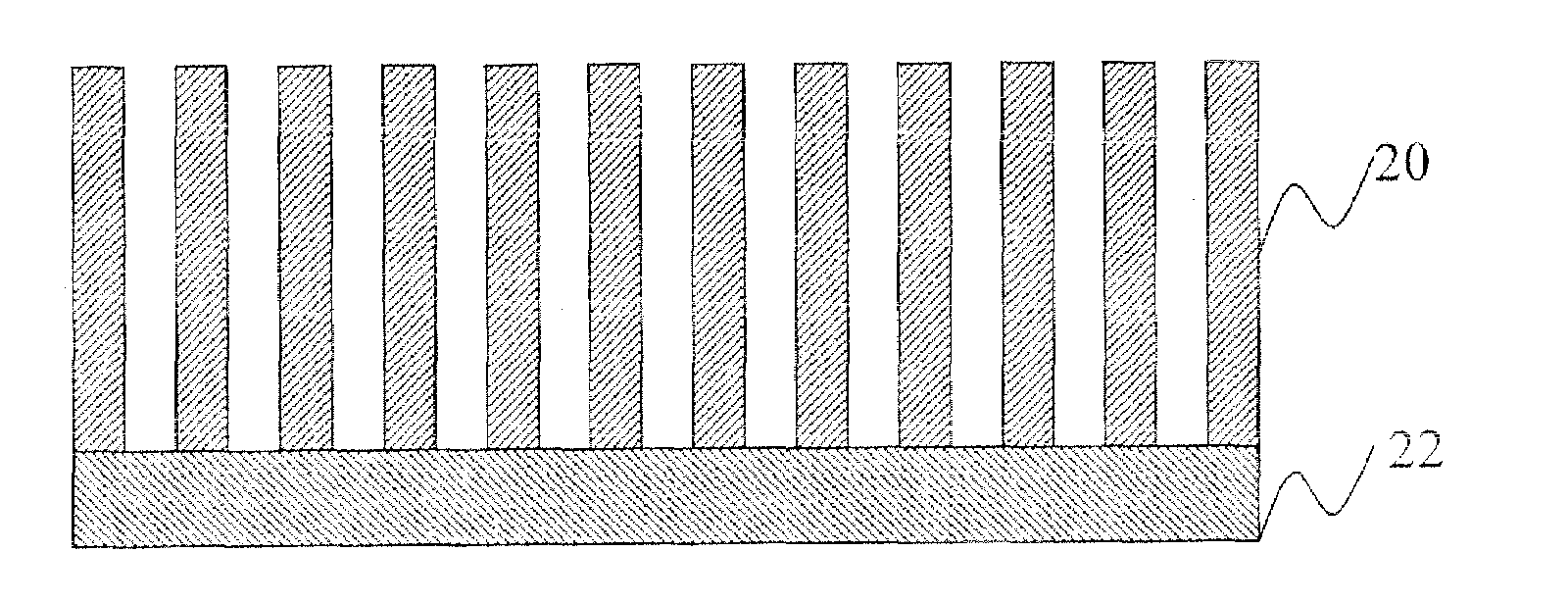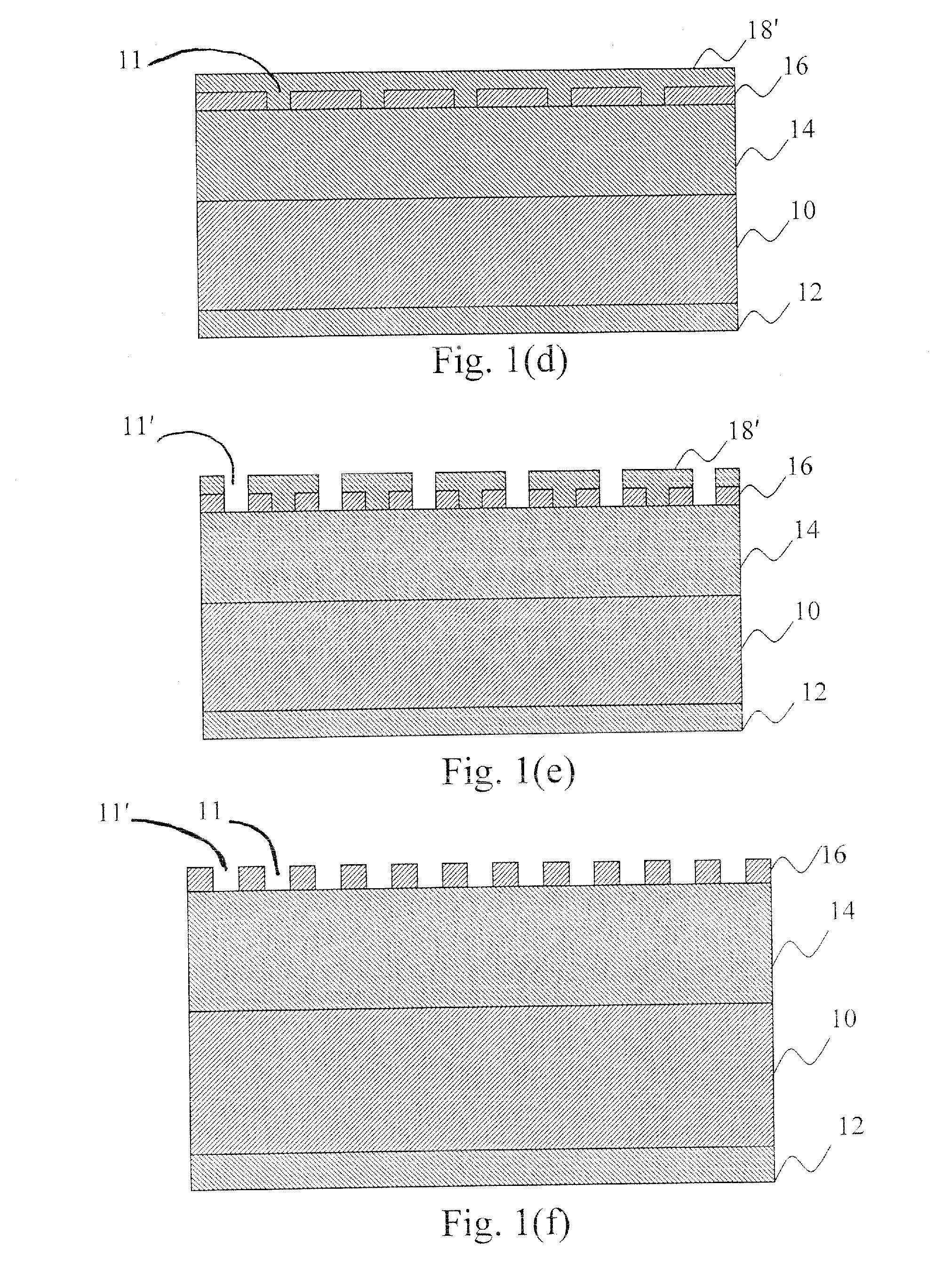On-track process for patterning hardmask by multiple dark field exposures
a technology of multiple exposure and hardmask, which is applied in the field of fabricating semiconductor structures by microphotolithography, can solve the problems of high cost and high unproven potential for small cds, and high cost and complexity of multiple exposure process
- Summary
- Abstract
- Description
- Claims
- Application Information
AI Technical Summary
Benefits of technology
Problems solved by technology
Method used
Image
Examples
example 1
Hardmask Formulation I
[0046]In this procedure a developer-soluble hardmask was formulated using the ingredients from Table 1. The ingredients were added to a flask in the order listed below and mixed under agitation. The mixture was filtered through a 0.1-micron membrane to remove particles. The formulation was then spin-coated onto a silicon wafer at 2,000 rpm for 40 seconds, followed by a two-stage bake at 120° C. for 40 seconds and then at 200° C. for 60 seconds. The thickness of the resulting film was measured to be about 75 nm±5 nm. The index of refraction of the film was measured to be about 1.6±0.05 at 193 nm, about 1.8±0.05 at 248 nm, and about 1.7±0.05 at 365 nm. The extinction coefficient of the film was measured to be about 0.38±0.05 at 193 nm, about 0.39±0.05 at 248 nm, and 0.42±0.05 at 365 nm.
[0047]The wafer was then immersed in TMAH while the analyzer measured the rate at which the film was removed. This film's dissolution rate in 0.26N TMAH was measured to be about 3 ...
example 2
Vias Created on Hardmask I by Double Exposure-Development
[0048]In this Example, a film stack was prepared using hardmask formulation I from Example 1. The developer-soluble hardmask was spin-coated onto a silicon substrate (100-mm wafer) at 2,000 rpm for 40 seconds, followed by a two-step thermal curing process. In particular, the wafer was heated at 120° C. for 40 seconds and then at 200° C. for 60 seconds on a hotplate. The thermally-set, developer-soluble hardmask formed a film having a thickness of 75 nm.
[0049]A commercial photoresist for i-line (365-nm) photolithography (SPR-950, from Rohm and Haas) was diluted with 2-heptanone to one-fifth of the original solids content. The diluted photoresist was spin-applied onto the hardmask to form an imaging layer. The wafer was then baked at 90° C. for 60 seconds as a post-application bake (“PAB”). The imaging layer had a thickness of 80 nm.
[0050]Next, the wafer was exposed with a photomask on a GCA Model 3300™ stepper NA=0.43) to radia...
example 3
Synthesis of Silicon-Containing Polymer for Hardmask Formulation II
[0052]In this procedure, 2 grams of styrene (Aldrich, Milwaukee, Wis.), 5.6 grams of methacrylic acid (Aldrich, Milwaukee, Wis.), and 12.4 grams of methacryloxymethyltrimethylsilane (Gelest, Morrisville, Pa.) were dissolved in 180 grams of PGME in a 3-neck round-bottom flask. The flask was degassed with dry nitrogen for 10-20 minutes. Next, 1 gram of azobisisobutyronitrile (AIBN, Aldrich, Milwaukee, Wis.) as a catalyst was added, and the mixture was stirred at room temperature until the catalyst completely dissolved. The flask with was then immersed into a preheated oil bath of 80° C. Nitrogen was introduced to the flask at a rate of about 5 mL / min. A condenser with water cooling was fitted into the center neck of the flask for refluxing. After 16 hours of reaction under constant stirring, the flask was removed from the oil bath and cooled down in the air to room temperature.
[0053]The contents of the flask were then ...
PUM
| Property | Measurement | Unit |
|---|---|---|
| thickness | aaaaa | aaaaa |
| wavelengths | aaaaa | aaaaa |
| wavelengths | aaaaa | aaaaa |
Abstract
Description
Claims
Application Information
 Login to View More
Login to View More - R&D
- Intellectual Property
- Life Sciences
- Materials
- Tech Scout
- Unparalleled Data Quality
- Higher Quality Content
- 60% Fewer Hallucinations
Browse by: Latest US Patents, China's latest patents, Technical Efficacy Thesaurus, Application Domain, Technology Topic, Popular Technical Reports.
© 2025 PatSnap. All rights reserved.Legal|Privacy policy|Modern Slavery Act Transparency Statement|Sitemap|About US| Contact US: help@patsnap.com



